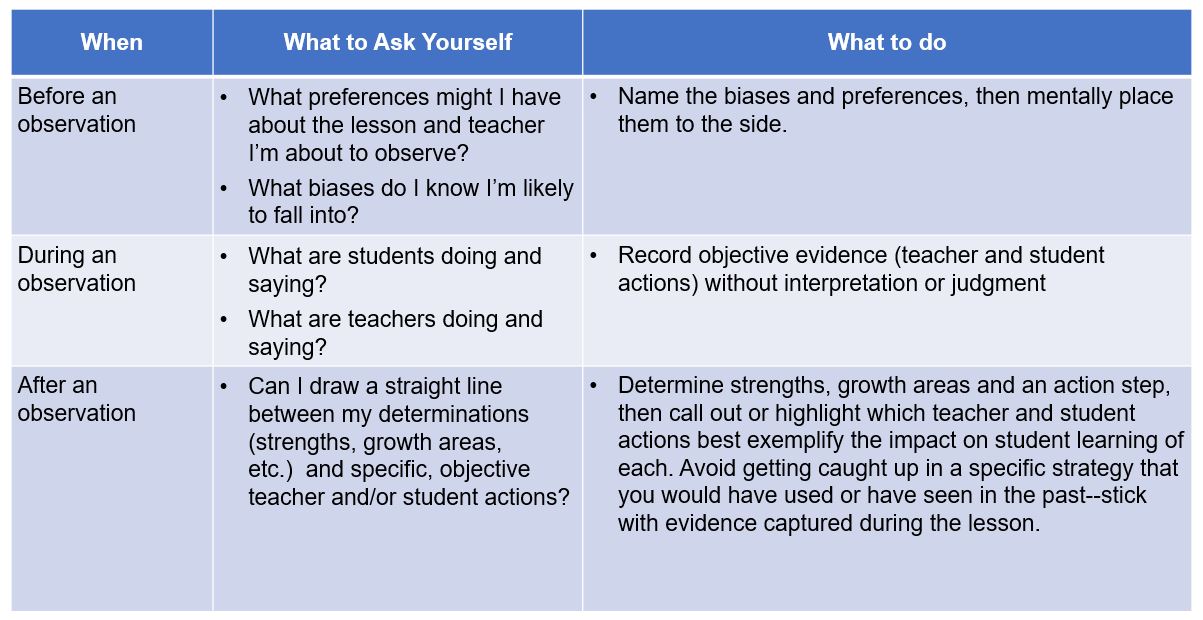Posts Tagged ‘Leadership’
Stay Conversations in the 2021-2022 SY
Our team has talked before about the importance of Stay Conversations as a crucial tool for staff retention. In the past, Stay Conversations have been about getting teachers and school leaders to return for the following school year. This year is different. This year is not only about retention for next school year, but also retaining people through the current school year. The 2021-2022 school year has been unbelievably hard. Across the country, schools are understaffed. Those who remain are being asked to go above and beyond: covering for vacant positions and for teachers who are absent or quarantined, supporting students who have endured emotional trauma and had significant disruption in their learning, and working in challenging physical conditions while worrying about their own safety. We’ve already seen the “Great Resignation” and unfortunately, it’s likely to get worse before it gets better.
Leaders will not be able to recruit their way to solving this crisis. Instead, leaders will need to focus on retaining the people they do have. One retention strategy is the Stay Conversation. These conversations typically occur before the December holidays as a way to affirm a leader’s desire for their staff to continue at the school the following year and preempt a holiday vacation job search. These conversations are recommended for staff in all roles including teachers, operations, and leadership.
Stay Conversations are a tried and true retention strategy that we encourage school leaders to continue during this unique year, but with a few important revisions to the approach and an updated conversation guide:
- More Frequent Stay Conversations: Rather than just meeting once a year for a Stay Conversation, we recommend meeting 2-3 times this year (including just before the winter break) to ensure that staff are regularly hearing important messages and have a one-on-one opportunity to voice any concerns. This may sound like a lot of time, but a 10 minute conversation is much less time consuming than the time spent covering a vacancy.
- Detailed Tracking: People’s personal situations and needs have changed frequently and rapidly throughout the pandemic. With each conversation, make sure to add to your Talent Tracker additional details about each individual such as the teacher’s current school roles (official and unofficial), how they are being recognized for their work, their relevant personal circumstances, and their desired situation (long and short-term).
- Planning Possible Offers: Before the very first conversation, prepare 1) what policies you can put in place to support and recognize all staff and 2) what you may be able to offer to staff who have a special need. It’s important to plan these in advance so that there is equity in the arrangements that are made, not just being provided to the best negotiators. Note that these offerings can be monetary, recognition, or other things that are valued by the individual.
- Example All-Staff Policies:
- All staff may be asked to work up to one hour per week covering other classes. Any additional coverage over that hour will be compensated work at an hourly rate (accessing vacancy savings and ESSR funds).
- Lunch duty coverage includes a gift card/voucher to purchase meals.
- Public recognition each week of staff who are taking on additional responsibilities.
- Example Individualized Plans (with rationale for who gets it):
- Late start-time so a parent can drop their child off at school.
- Late start-time so a parent can drop their child off at school.
- Example All-Staff Policies:
- Communicate Impact: Clearly communicate the significant impact the person is having in the school. Ask staff directly to stay through the entire school year.
- Broader Strategy: Stay Conversations are powerful, but they are not enough on their own. Consider all the ways to ensure people feel valued, feel successful, are growing, and have flexibility to meet the demands of their lives.
- Set Yourself Up for Success: Consider the day, time, and environment that will set you, as the leader, up for success. You cannot pour from an empty cup so make sure you are in a good place yourself. One idea is to lead these conversations in the morning, before other distractions of the day.
We’re providing this updated 2021-2022 Stay Conversation Guide (adapted from a tool developed at IDEA Public Schools) to support you in leading important conversations in this critical year. We hope it helps you to meaningfully connect with your team members and results in strong retention. Please share your feedback so we can continue to improve the tool for others. Y
Are You a Leader Feeling Stuck Right Now? Ask Yourself These Questions
Leaders make sense of things for others, untangling knots of confusion and ambiguity. This responsibility compounds during a crisis and is even harder when you are feeling like a mess yourself!
To “un-mess” myself, I like to use a strategy that worked for me as a kid – some good old-fashioned self-talk – ala Lev Vygotsky. My grown-up version of self-talk takes the form of questions that I ask and answer myself (I only occasionally do this out loud). The good news is they’ve also worked well for my colleagues and the people I coach – and I hope they will for you too.
1. Am I keeping the mission and values central to every decision I am making? Remembering why you do the work and what you stand for–and will not stand for—are critical to good decision-making and productivity in a crisis. We all need to be grounded or anchored, and this question always gets me back to center.
2. What can I simplify at work, in my life, and for my team? Accomplishing even the simplest things can seem insurmountable when your world is turned upside down. Our economy shutting down, communications rhythms changing, and having your whole “way of working” change overnight has had pretty serious ripple effects. A strong leader works to simplify things for themselves and for their team. Doing so can focus a team and allow them to even feel motivated with newfound direction.
3. How can I work collaboratively to identify bias, blind-spots, and inequities in our decisions and work without thwarting decisiveness? Even if it isn’t within your normal mode, you’ll have to move fast to make decisions and to give direction in crisis. Acting on instinct and doing so confidently provides what seems most needed – guidance. However, our instincts are inherently biased and we have blind spots. We can’t let the need to provide guidance and decisiveness over-ride informed decision-making. Take a second, ask a trusted colleague, mentor or team-member to check your thinking and make sure it’s someone who thinks differently and is willing to challenge you.
4. How am I adding value or support during the interactions that I have? If you’re leading a team, it’s likely that you’re getting bombarded with questions or working to keep people engaged while managing your own stuff (which is very real right now). In this harried time, there’s a big risk that some of these interactions devolve into transactions. Getting things done now is important, but you have to remember that the fight against inequity is an ultra-marathon; and building team and developing people can’t be lost in all of this. Make sure that you are entering conversations and interactions with intention and aiming to add value in as many interactions as possible.
5. Am I keeping my team and those around me appropriately updated (without overwhelming them)? You are likely hearing all sorts of news from every direction – schools are staying closed; the budget situation is going from bad to worse; inequities are deepening, and trauma is reigning. As a leader you have the unenviable position of knowing all of these things. Part of your job is to keep your team updated, but appropriately: giving people the information they need to do their best, transparently, without causing undue stress or concern by sharing too much.
6. How can I consistently be straightforward about where we are and what we still don’t know while still having relentless hope about the future? Mandela taught us that courage was not the absence of fear but the triumph over it; and Stockdale taught us that a brutal honesty about our realities paired with an unwavering confidence that we’ll prevail is key to thriving. Leaders must be clear about both the challenges we’re facing and have confidence that we’ll win in the end—because we have to. Pragmatic optimism is the key, especially in a time when, more than ever, people need the truth and hope.
Getting to clarity is hard enough to do on your own right now, much less for a team or your entire organization, but it’s sorely needed. Engaging in some disciplined reflection before or while you act will ensure that you, and more importantly, your teams and stakeholders will have a much clearer pathway forward – which is exactly what we need right now.
– Jeremy
Special thanks to Gallup and Impact Ladder for inspiring some of these questions.
Leaders, It’s Okay to Take Off the Cape
Leadership is difficult in good times. In times of crisis, this difficulty grows exponentially. This notion has become even more clear through my work supporting a Chief-level leader through the restructuring of a network of schools. This leader’s plate was full before the COVID crisis hit, and their responsibility and leadership scope has essentially doubled as a result of COVID: becoming responsible for orchestrating the network’s response to the abrupt closure of schools, and most significantly designing and implementing virtual instruction. Daily they are responding to questions and concerns from families, teachers, staff, and principals, and are looked to by staff to both assuage fears and set a concrete vision and plan for next steps.
My client reflected on having to spend all of their time being “on.” Conference call after call, zoom meeting after meeting, this leader has to be the one with all the answers, or the plan to find the answers. Staff call them for advice and support, or to complain about the way other team members are responding. And my client has to be there to listen, console and plan. All day, every day.
Yes, great leaders provide security and vision to their teams to manage through crises, but fulfilling that role is incredibly draining. Last week, my client and I reflected on how nice it is for them to have a chance to “take off the cape” during our check-ins: to not have to have all the answers, to be able to complain about how difficult all of this is, and to express disappointment, fear and anger honestly. I was honored that my client saw our check-in as the time for them to take that guard down and to be able to react to and reflect on how the work was weighing on them. It also provided an opportunity for us to brainstorm ways that we can handle the burden of leadership to meet the needs of staff without burning out.
I also saw this as a reflection of what we at Hendy pride ourselves on: walking arm-in-arm with our clients as they design solutions and create programs to better serve teachers and kids. Sometimes that relationship means gently pushing our clients to do something differently; other times it means accelerating full speed ahead on executing a plan. In these crazy times, it has sometimes meant simply providing a space for our clients to “take off their capes”, to reflect honestly about the difficulties of being a leader in crisis, and to know that leading others requires us to take care of ourselves.
-Jess
Yes, You Can Stop Doing That
Before COVID-19, education leaders prided ourselves in being goal oriented professionals, doing everything in our power to support student success. Working in schools, districts, CMOs, state departments of education and in supporting organizations, we took pride in our commitment to do whatever it takes, knocking through barriers, and always maintaining high expectations for ourselves and others.
But now, that day is over. Or at least on pause. We are balancing full days of meetings with full days of homeschooling our own children, we are nursing ourselves or our families back to health, we are facing fear, frustration, and grief. Our lives have changed and so too must our expectations for ourselves and for others.
Talking with talent leaders across the country, We’re discovering that many simply need to hear, “You can stop doing that. It will be ok.” It’s time to re-prioritize and focus on the purpose of your work, not stay wed to the original plan or program. Schools can be our model. Teachers and principals are learning a whole new way to educate students. They are no longer teaching the same lesson plan, but they are working toward the same standards, ensuring that students are able to learn and grow. District and network leaders need to do the same.
For example, we were recently asked by talent leaders in both a big urban district and in a big charter network about how to continue their robust evaluation systems. While we firmly believe in systems of teacher development, evaluation, recognition and pathways (and have spent most of my career focused on them), now is the time to pause and reassess. It’s the time to ask yourself what the ultimate purpose of your work is and if your system is doing that now. It’s time to simplify and focus on achieving that original purpose, not to MacGyver a complicated and time consuming process. When we talked with leaders about their multiple measure evaluation systems we were direct – your student achievement measures based on interim data aren’t going to be accurate and won’t help teachers get better, so don’t do that. Your families don’t have time to give feedback on teachers, so don’t do that. Your teachers aren’t teaching in ways that align to the observation rubric and had to learn this new method in a day, so don’t do that. Instead, coach and support the adults to do the best they can in a tough situation so they can be their best for kids.
The purpose is always to support people to get better and stay longer.
Is your system doing that now?
As a talent leader, we recommend focusing your time and energy into five priorities:
- Communicate clearly and transparently – State what you know and what you don’t yet know. Be clear about the values that are driving decisions and what is being prioritized right now. Be real about your own fears and your own optimism. And find ways to connect. You can share a video, hold office hours or reach out one on one. In doing so, always focus on the employee’s needs as a person.
- Listen to and support your school leaders – School leaders are struggling through this time, navigating their own emotions and disappointments, and those of their teachers, students and families. Be responsive to their needs and make them your priority. When you need their input, make it as easy as possible for them. Give them a clear proposal and let them react.
- Retain your staff – Have “stay conversations” so people know they are valued and appreciated. Ask them directly through conversations or surveys what their plans are for the fall. Consider how to retain salaries through limited budgets and how to incentivize people through non-monetary compensation.
- Recruit and hire new candidates – Hiring will need to move online, but keep the process moving. Think about how to get hiring managers comfortable granting offers remotely and how to get candidates comfortable to accept offers. Identify how to bring your schools’ unique culture to candidates. For more, check out TNTP’s Virtual Hiring Guide and Fast Company’s article on unconscious bias.
- Recognize and celebrate people – Consider cancelling performance based rewards based on results from 2019-2020 and re-use these funds to recognize teachers now (or returning teachers in the fall). Identify ways to say thank you for the hard work and creativity people are bringing to the work. For example, a personal thank you message, a take-out restaurant gift certificate or a retention bonus at the start of next school year are all effective in letting people know they are appreciated.
As our fearless talent leaders, we want to say thank you for taking care of the adults so they can take care of the children. And, yes, you can stop doing that.
Listen Up: Hendy Avenue on EdPOP Podcast
Curious to learn more about Hendy Avenue Consulting? Our very own Jessica Wilson sat down with the host of EdPOP to talk about our mission, recent projects and how talent strategy can make the difference for kids across the country.
Three Steps to Avoid Common Observation Biases
We all have biases. Whether picking an ice cream flavor or choosing to take the scenic route rather than the highway, we all operate with mental models that place disproportionate weight on certain factors that move our judgment in favor of one option when compared to another.
When observing and evaluating teacher practice, there are numerous opportunities for biases to creep in. Just think of all the factors that go into a lesson: the subject, grade, school, teacher, time of day, lesson structure, materials used and more. An observer may think to themselves, “the students were well-behaved for the first class right after lunch”. A different person observing that same lesson may think, “if I was teaching this class, I would have used a different text.” Both of these sentiments may be true, but they have to be placed aside before conducting a visit so that observers can focus on objective teacher and student actions.
In short, great observers, coaches, and evaluators must identify, then set aside, biases in order to fairly and accurately evaluate and develop teacher practice.
Common biases include:
- Confirmation bias: the tendency to search for or interpret information in a way that confirms one’s preconceptions,
- Halo effect: the tendency for a person’s positive or negative traits to “spill over” from one area of their personality to another in others’ perceptions of them, and
- Mirror bias: the tendency to judge performance as “good” if it is “like I would have done it.
A full table of common observer biases with examples can be found here: Observer Bias Examples
In order to mitigate the impact of these biases, great observers should ask themselves three questions:

Round 3: Looking Back, Looking Ahead
In our previous two posts (here and here), Sarah and Grant shared reflections on the past year and projects they are looking forward to in the coming months. To bring us home, Jessica shares lessons learned on working through complexity and opportunities to lead with appreciation.
What I learned: I have spent most of my career in education supporting and working in large bureaucracies, namely large urban districts and state education agencies. Just prior to joining Hendy Avenue I was in senior leadership in one of the largest school districts in Ohio. Each of the organizations I’ve worked with in the past have faced challenges, and I tended to chalk those up to organizational complexity, and the difficulty that comes with arriving at solutions when you must invest a large number of people and perspectives in the strategies. After spending my first year with Hendy working with diverse organizations and districts, I came to appreciate that the challenges I faced in past contexts are not so different from those faced by clients of all sizes. I’ve learned that it’s often not only the scale and bureaucracy that causes the challenges we face in K-12 education, and that we can learn a lot from organizations of different sizes and types in finding solutions. As we partner with our clients this year, we are excited to continue to bring lessons learned from all shapes and sizes of districts, states, schools and networks to arrive at solutions to problems.
What I’m excited about: I am so happy to get to continue to partner with Independence Mission Schools in Philadelphia. Having attended Catholic schools as a child, I have a great appreciation and admiration for the work IMS is doing for some of Philadelphia’s most deserving students. We learned a lot from IMS’ leaders and teachers as we supported them last fall to implement their new instructional framework, and to modify that framework to fit their Catholic culture. Now, I’m excited to continue to support IMS leaders as they deeply invest in teachers through teacher leadership. This project has been a welcome opportunity to explore how others are solving a problem, learn more about the context, strengths and opportunities in IMS schools, and devise a program that makes a difference for teachers, and students, across the network.
Round 2: Looking Back, Looking Ahead
In our last post, Looking Back, Looking Ahead: Lessons Learned and What’s to Come in 2018-19, our founder Sarah shared insights on the difficulty of leading change and the excitement around re-engaging with one of our first partners.
This week, we hear from Grant:
What I learned: Historian and philosopher Will Durant said, “we are what we repeatedly do. Excellence, then, is not an act, but a habit.” Durant’s much-quoted line rings true in most endeavors, especially in efforts to drive change. Over the past year, we’ve seen the power of habitual communication–to teachers, school leaders, regional administrators–in sharing consistent messages, building shared understanding and demonstrating competence. Nothing derails stakeholder buy-in more than mixed messages or a lack of information! Habitual communication requires consistent content, format, and tone through a single channel at a regular, expected frequency. In Houston, we’ve supported KIPP in the development of a weekly message to School Leaders around implementation of Teacher Pathways. Each Friday, leaders know they will receive updates, shout outs, resources, and reminders to guide the week ahead. In Delaware, we’ve launched a monthly newsletter for district leaders on DPAS_II, the state’s teacher evaluation system, with a consistent agenda including deadlines and professional development opportunities. These habitual communications do more than provide information, they demonstrate competence and care for colleagues and trust between stakeholders. As you think about the programs you’re leading, consider how you can habitualize communication as a repeatedly do.
What I’m excited about: In 2014, KIPP Texas – Austin began a comprehensive effort to reshape teacher effectiveness and retention through the development of a Teacher Career Pathway. Knowing that great teachers drive student achievement, Austin’s Teacher Career Pathway develops, recognizes and rewards excellent educators so they will get better and stay longer. This fall, the first cohort of Distinguished Teachers will be announced; a group of accomplished educators who have demonstrated consistent gap-closing results for kids, impeccable teaching practice and exemplary professional contributions to the school community. We cannot wait to celebrate these remarkable educators!
Looking Back, Looking Ahead: Lessons learned and what’s to come in 2018-2019
As consultants, our role is to guide our partners to make informed decisions and to successfully meet their goals. We also prioritize building the knowledge and skills of our partners and they tell us that they learn a lot from working alongside us. In turn, we learn so much every day from the incredibly smart and diverse partners we have the good fortune to work with!
As we reflect on the past and look ahead to the new school year, we are grateful for all that we have learned from our clients. In our next couple of blog posts, each Hendy team member will share something he or she has learned and something we’re excited about it. It’s going to be a great year!
To kick us off, read below from our founder, Sarah Rosskamm:
What I learned: Change is hard. Often times the solution is to prepare for change, engage stakeholders, continuously communicate the “why”, work with influencers, plan for challenges and ultimately to just keep going even when it gets tough. There are times, however, when the solution is to pause, reflect and change course. In working with one of our partner charter networks this year, we learned that sometimes the most courageous and best answer is to stop doing something. In this case, our partner was eager to build a teacher career pathway. They took many important steps to get there, had buy-in from leaders and momentum from teachers believing it was valuable. However, they also had budget changes, shifts in capacity and new demands of their attention. As a result, they smartly decided to pause. They stopped putting their attention into the pathway and instead narrowed the scope of their focus to implementing a highly effective evaluation and development structure that would help their teachers to grow and enable them to target their professional learning activities. They focused on laying a foundation that would immediately benefit teachers through continued growth, and will ultimately allow them to move more quickly toward a pathway if and when they choose to pick it up again. It wasn’t easy (for the network or for the Hendy team) to not complete our original shared goal, but it was the right thing to do for their teachers and students.
What I’m excited about: Hendy Avenue’s very first consulting project was supporting the Delaware Department of Education as they considered revisions to their teacher evaluation rubric. After considering several rubric options based on the best of the available rubrics at the time, the Delaware team, similar to the team described above, decided to pause and learn more before making changes to a statewide tool. So, we shifted course and supported four charter schools in Wilmington to design and implement an alternative evaluation system for their teachers that would utilize this new rubric. I worked closely with the leaders in those schools for several years and together we instituted an alternative system that is now used in a growing number of Delaware schools through their Alternative Evaluation system. I am so excited that five years later, after learning a great deal about the use of the current rubric and about the alternative system, Delaware leadership is eagerly partnering with teachers, leaders and other stakeholders to revise the rubric to ensure the tool is well-aligned to new standards and meets the needs of teachers across the state. I’m also thrilled the state has very wisely decided to prioritize involvement of teachers and leaders in the process and to take the time necessary to ensure it’s a positive and welcomed change for their well deserving teachers. And I’m even more excited that Hendy Avenue will be partners in engaging stakeholders, designing, piloting, revising and ultimately building a rubric that helps teachers and leaders be the very best they can be for their students.
Making Teacher Leadership a Success
In our first post on teacher leadership, we noted a few key ideas and benefits of extending the impact of teachers. Here, we break down three suggestions for launching a new teacher leadership initiative as well as criteria to measure success and common pitfalls to avoid.
How do you launch a successful teacher leadership program?
Our research and experience suggest three critical steps to starting a new approach to teacher leadership:
- Start with a goal in mind: Avoid launching a new program without a clearly defined, and important problem to solve. For example, if your district finds that teachers are not feeling valued in decision making, a teacher leadership program aimed at increasing teacher voice would be more appropriate than a peer coaching initiative.
- Identify the right “strand” of teacher leadership: Teacher leadership can be instructional (coaching, learning communities, etc.), associative (organizing, community building, etc.) or policy focused (advocacy, implementation feedback, etc.).
- Build a leader profile and plan for their development: Identify the specific knowledge, skills, and mindsets teacher leaders will need to be successful. Consider the personal or professional goals teacher leaders could be working towards and how they’ll be held accountable to meeting the expectations for their role.
Criteria for Success
Successful implementation of any initiative requires specific benchmarks in order to direct action, mobilize energy and inspire persistence. At the same time, setting goals is not enough. In addition to guidance, training and coaching, people need the capacity to act.
Here are four criteria that leaders can use to achieve success:
- Alignment: Ensure teacher leadership priorities are aligned with overall school priorities.
- Goals: Collaboratively set and track progress against clear, measurable goals for teacher leadership.
- Systems of Support: Identify a clear, cohesive system of support for teacher leaders to drive their professional growth and success.
- Schedules: Carefully plan and agree upon scheduling to guarantee teacher leaders have the time to succeed.
Common Pitfalls
The work we do as educators is difficult. Leaders often find themselves constrained with limited budgets and capacity to drive change; while teachers often wish for another hour in the day to make that additional phone call home or photocopy for the next day.
In launching a teacher leadership program or opportunity, look for, and avoid the following common pitfalls:
- Temporary: Teachers notice when positions are tenuous. Avoid funding sources that may not persist long enough to influence recruitment and retention.
- Detached: Roles that prevent teacher-leaders from spending a portion of their time teaching students make it much harder for them to keep teaching skills fresh and stay connected to student needs.
- Low reach: Many teacher-leadership roles actually reduce the number of students for whom the best teachers are responsible. If fewer students benefit from the best teachers, fewer will make the learning gains these teachers induce.
- Short on time: Too many teacher-leader roles are heaped on top of teachers’ other responsibilities. Co-planning, modeling, co-teaching, coaching, and collaboratively adjusting instruction based on student data require more planning time.
- Low or no pay: Most teacher-leader roles are low- or no-pay roles; this sends the message that teacher leadership is expendable, rather than essential to schoolwide success.
- Low authority, low accountability: Teacher-leaders’ formal authority and evaluations rarely align with responsibility for wider student spans and a positive impact on peer and students success.
How has has teacher leadership made in impact in your school or career? What led to success? What should be avoided? Sound off in the comments!
Sources:
- York-Barr, J. and Duke, K. “What do we know about teacher leadership”. Review of Educational Research. (2004)
- Karen Seashore Louis, Kenneth Leithwood, Kyla L. Wahlstrom, and Stephen E. Anderson, “Investigating the Links to Improved Student Learning,” University of Minnesota (2010).
- Louis, Leithwood, Wahlstrom, and Anderson, “Investigating the Links to Improved Student Learning”
- Leading Educators and the Aspen Institute, “Teacher Leadership that Works,” Aspen Institute (2014).
- C. Kirabo Jackson and Elias Bruegmann, “Teaching students and teaching each other: The importance of peer learning for teachers,” National Bureau of Economic Research No. 15202 (2009);
- Cory Koedel, “An empirical analysis of teacher spillover effects in secondary school,” Economics of Education Review, Vol. 28, 682–692 (2009);
- Kun Yuan, “A value-added study of teacher spillover effects across four core subjects in middle schools,” Education Policy Analysis Archives, Vol. 23, no 7 (2015).









